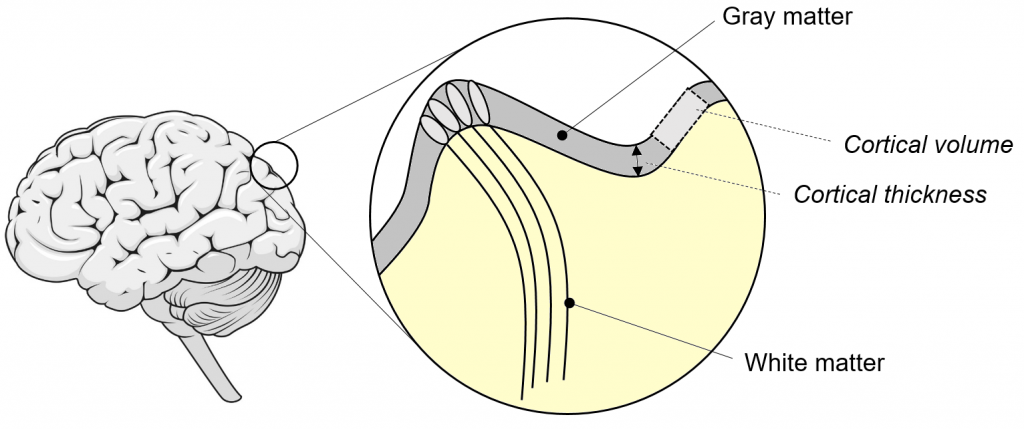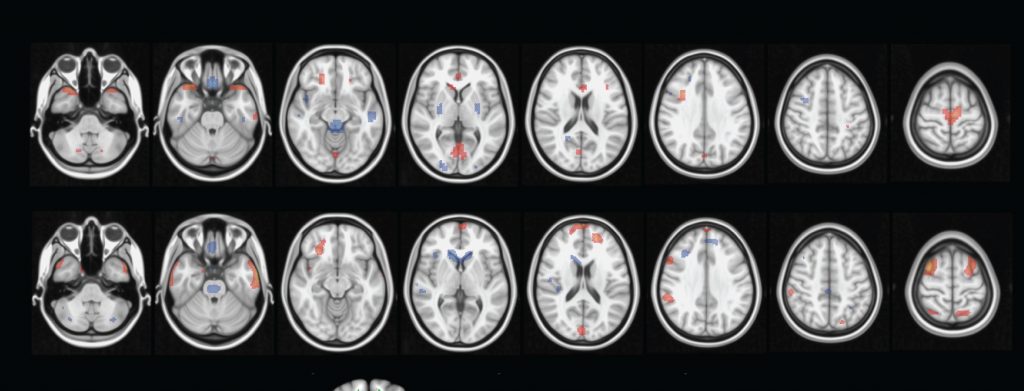This post is also available in Dutch.
How the shape of our brain defines who we are and how we act has been a question of interest since antiquity. With new ways to obtain high quality images of the brain using magnetic resonance imaging (MRI) and the collection of large amounts of information from healthy volunteers, we are now able to investigate how brain structure relates to a broad scope of human characteristics and behavior.
Brain structure
There are several different types of brain structure that are typically used in research: the size and thickness of grey matter, which contains the bodies of your brain cells, and the white matter tracts that connect them (see diagram below). You can think of this structure as a country, where gray matter is like the cities where work is done and activity happens, while white matter is like the roads and railways connecting those cities to each other.

Brain structure varies a lot between people and, even within a single person, changes throughout life. How the shape and connections of your brain are affected by what you experience and how this is related to the way you function is of great interest to neuroscientists. While earlier research usually looked at only one measure of brain structure (either gray or white matter), new methods (such as “linked-independent component analysis”) in neuroscience now enable us to link together these types of information. By doing so, we can define patterns of brain structure that are strongly connected to one another and take relevant information from different types of brain scans. Such a pattern will, for example, include information about the size of a certain region, the thickness of the grey matter in another region and the white matter tracts that connect them (in the country-city example, this would be like using a city’s areal size, another city’s population density, and the roads that connect the two cities). By obtaining these patterns of brain structure, we can then see how each person fits into these patterns.
The “positive-negative” mode
By using a large sample of healthy adults (such as 500 subjects from the “Human Connectome Project”), we can then check how our structural patterns relate to over 300 different characteristics and types of behavior. These range from relatively straightforward things such as age and sex to complex information like personality, life satisfaction and stress. In this same group of subjects, research has previously shown that spontaneous brain function (as measured by functional MRI during rest) strongly relates to a substantial list of demographics and behavior. These include:
- Physical characteristics (e.g. gender, weight and blood pressure)
- Scales on more complex demographics (e.g. life satisfaction, stress, loneliness and family history of drug abuse)
- A set of the cognitive tasks performed (e.g. picture vocabulary task, working memory and fluid intelligence).
As it includes a wide range of information, this set was dubbed the “positive-negative” mode. As it turns out from recent work, this positive-negative mode is not just found in the function of the brain. By using the patterns in brain structure as explained above, we can also find the same variation in human behavior. This pattern includes areas of the brain related to language and working memory and white matter tracts connecting these regions to one another. How a person varies on this pattern in structure is strongly related to how they vary on the measures in the aforementioned “positive-negative mode”. If we look at all of the different types of brain structure together (instead of just one), most behavior that has previously been linked to brain function might in fact be linked to brain structure instead. This has large implications for other work because, as mentioned before, most research focuses on a single type of measure and might relate behavior to brain function, while it may actually be more directly related to brain shape.
Original language: English
Author: Peter Mulders
Buddy: Christienne Gonzales Damatac
Editor: Marisha Manahova
Translator: Jill Naaijen
Editor Translation: Wessel Hieselaar
